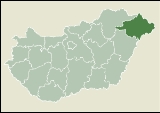
Lónya
Encyclopedia
History

In the 13th century the village had been possessed by Bánk Peer. After he had assassinated Queen Gertud, his tenure had been seized by King Endre II. The King endowed the village to the Berenczeis in 1285. The descendants of the Berenczei had used the family name ”Lónyay” after this donation. In this time the village divided into two part: Kislónya (Small-Lónya) and Nagylónya (Great-Lonya). The Romanesque church was built in the 13th century. In the year of 1567 the Mongolians had been burglarized the village. The Lónyays confess to the Reformed Church (Calvinist) in the early time, in the middle of the 16th. Kis and Nagylónya were united as Lónya in 1934. The village used to lie closer to the river, but the inhabitants had to move further up, to the current position, because of frequent floods. Although the village was rebuilt, there are still a few special barns left. Today, most of the 900 inhabitants live by the main street and produce mainly wheat, corn, sunflower seeds, apples and plums.
Sights
Romanesque church (13th century)Wooden bell-tower (18th century)

Park of the former Lónyay Castle
A 6.3 hectare castle park surrounded the Lónyay castle, and although the castle was destroyed in a fire in 1965, the walk in the famous and unique horse chestnut tree rows still exist. There are also five pyramid oaks, each about 26 metres high and 120 years old, as well as some maple trees which also must be about 100 years old. The richness of nature is also proved by a healthy elm tree in the Long-pasture, which is 25 metres high, and 3 metres in circumference.
Forest of Lónya
The Lónya forest is part of the Szatmár-Bereg Nature Reservation District. The forest by the border is scattered with beautiful hornbeam and oak trees, as well as ash and elm trees. On the southern edge is the so-called Mélyéger alder moor. In the north it is bordered by the country border and the Csaronda stream. The older species of the oak, ash, and elm trees in the 407 hectare grove are about 70–80 years old, but even the younger ones are older than 50 years. The grove is so isolated that red deer are only found here in the Bereg forests; there are about 50 of them, and some have capital antlers. Wild boars and roes, as well as black storks and wild cats can often be seen here. There are also vipers living here, so it is recommended to wear rubber boots when walking in the forest. Outside Lónya a hunting lodge is waiting for the hunters.
Illustrious villagers
- Menyhért Lónyay, Former prime minister of Hungary
- Jolan BabusJolan BabusJolán Babus was a Hungarian ethnographer and teacher.-Life:She was born in Košice, which is now part of Slovakia. In 1920 her family moved to Lónya, where her father was a Calvinist priest. From 1936 she attended to the Teacher College of Debrecen where she taught Faculty of Arts. In 1943 she is...
, Ethnographer-teacher

